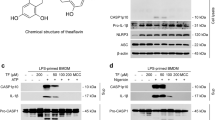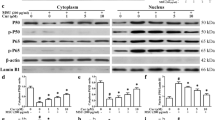Abstract
Monosodium urate (MSU) crystals are an endogenous sterile particulate that has been identified as a potent damage-associated molecular pattern (DAMP). In humans, the induction of IL-1β production through MSU-induced NLRP3 inflammasome activation in monocytes/macrophages is responsible for pathogenesis of gouty arthritis. It was recently reported that in a murine model of this disease, resveratrol decreases MSU-induced recurrent attacks of gouty arthritis. Despite its demonstrated anti-inflammatory effects, the mechanisms underlying resveratrol-mediated repression of IL-1β production in MSU-activated monocytes remain poorly understood. Here, we show that resveratrol suppresses secretion of active IL-1β by human primary monocytes stimulated with MSU crystals through suppression of Syk activation. Metabolic labeling and pull-down assays to investigate de novo protein synthesis clearly demonstrated that intracellular pro-IL-1β synthesis is rapidly repressed in monocytes after resveratrol treatment due to decreased phosphorylation of Syk and p38. Resveratrol also inhibited NLRP3 inflammasome activation in MSU-stimulated monocytes by suppressing oligomerization of ASC. Furthermore, resveratrol exerted a beneficial effect by reducing IL-1β production and inhibiting neutrophil recruitment in a mouse model of MSU-mediated peritonitis. Our findings suggest that resveratrol exerts anti-inflammatory effects via post-translational regulation of IL-1β production and, thus, may prove beneficial for the treatment of MSU crystal-mediated sterile inflammation.
Key message
-
Resveratrol has negative effects on pro-IL-1β synthesis through Syk and p38.
-
Resveratrol inhibits oligomerization of ASC.
-
Resveratrol is beneficial in a mouse model of MSU-induced peritonitis.








Similar content being viewed by others
References
Chen GY, Nunez G (2010) Sterile inflammation: sensing and reacting to damage. Nat Rev Immunol 10:826–837
Liston A, Masters SL (2017) Homeostasis-altering molecular processes as mechanisms of inflammasome activation. Nat Rev Immunol 17:208–214
Franklin BS, Mangan MS, Latz E (2016) Crystal formation in inflammation. Annu Rev Immunol 34:173–202
Rock KL, Kataoka H, Lai JJ (2013) Uric acid as a danger signal in gout and its comorbidities. Nat Rev Rheumatol 9:13–23
McCarty DJ, Hollander JL (1961) Identification of urate crystals in gouty synovial fluid. Ann Intern Med 54:452–460
Chen CJ, Shi Y, Hearn A, Fitzgerald K, Golenbock D, Reed G, Akira S, Rock KL (2006) MyD88-dependent IL-1 receptor signaling is essential for gouty inflammation stimulated by monosodium urate crystals. J Clin Invest 116:2262–2271
Jesus AA, Goldbach-Mansky R (2014) IL-1 blockade in autoinflammatory syndromes. Annu Rev Med 65:223–244
Bryant C, Fitzgerald KA (2009) Molecular mechanisms involved in inflammasome activation. Trends Cell Biol 19:455–464
Guo H, Callaway JB, Ting JP (2015) Inflammasomes: mechanism of action, role in disease, and therapeutics. Nat Med 21:677–687
Lu A, Magupalli VG, Ruan J, Yin Q, Atianand MK, Vos MR, Schroder GF, Fitzgerald KA, Wu H, Egelman EH (2014) Unified polymerization mechanism for the assembly of ASC-dependent inflammasomes. Cell 156:1193–1206
Martinon F, Petrilli V, Mayor A, Tardivel A, Tschopp J (2006) Gout-associated uric acid crystals activate the NALP3 inflammasome. Nature 440:237–241
Shakibaei M, Harikumar KB, Aggarwal BB (2009) Resveratrol addiction: to die or not to die. Mol Nutr Food Res 53:115–128
Jang M, Cai L, Udeani GO, Slowing KV, Thomas CF, Beecher CW, Fong HH, Farnsworth NR, Kinghorn AD, Mehta RG et al (1997) Cancer chemopreventive activity of resveratrol, a natural product derived from grapes. Science (New York, NY) 275:218–220
de la Lastra CA, Villegas I (2007) Resveratrol as an antioxidant and pro-oxidant agent: mechanisms and clinical implications. Biochem Soc Trans 35:1156–1160
Jimenez-Gomez Y, Mattison JA, Pearson KJ, Martin-Montalvo A, Palacios HH, Sossong AM, Ward TM, Younts CM, Lewis K, Allard JS, Longo DL, Belman JP, Malagon MM, Navas P, Sanghvi M, Moaddel R, Tilmont EM, Herbert RL, Morrell CH, Egan JM, Baur JA, Ferrucci L, Bogan JS, Bernier M, de Cabo R (2013) Resveratrol improves adipose insulin signaling and reduces the inflammatory response in adipose tissue of rhesus monkeys on high-fat, high-sugar diet. Cell Metab 18:533–545
Libby P, Ridker PM, Hansson GK (2009) Inflammation in atherosclerosis: from pathophysiology to practice. J Am Coll Cardiol 54:2129–2138
Lumeng CN, Saltiel AR (2011) Inflammatory links between obesity and metabolic disease. J Clin Invest 121:2111–2117
Huang Z, Wang C, Wei L, Wang J, Fan Y, Wang L, Wang Y, Chen T (2008) Resveratrol inhibits EMMPRIN expression via P38 and ERK1/2 pathways in PMA-induced THP-1 cells. Biochem Biophys Res Commun 374:517–521
Zong Y, Sun L, Liu B, Deng YS, Zhan D, Chen YL, He Y, Liu J, Zhang ZJ, Sun J, Lu D (2012) Resveratrol inhibits LPS-induced MAPKs activation via activation of the phosphatidylinositol 3-kinase pathway in murine RAW 264.7 macrophage cells. PLoS One 7:e44107
Kowalski J, Samojedny A, Paul M, Pietsz G, Wilczok T (2005) Effect of apigenin, kaempferol and resveratrol on the expression of interleukin-1beta and tumor necrosis factor-alpha genes in J774.2 macrophages. Pharmacol Rep 57:390–394
Chen H, Zheng S, Wang Y, Zhu H, Liu Q, Xue Y, Qiu J, Zou H, Zhu X (2016) The effect of resveratrol on the recurrent attacks of gouty arthritis. Clin Rheumatol 35:1189–1195
Chung YH, Kim DH, Lee WW (2016) Monosodium urate crystal-induced pro-interleukin-1beta production is post-transcriptionally regulated via the p38 signaling pathway in human monocytes. Sci Rep 6:34533
** HM, Kim TJ, Choi JH, Kim MJ, Cho YN, Nam KI, Kee SJ, Moon JB, Choi SY, Park DJ, Lee SS, Park YW (2014) MicroRNA-155 as a proinflammatory regulator via SHIP-1 down-regulation in acute gouty arthritis. Arthritis Res Ther 16:R88
Das S, Das DK (2007) Anti-inflammatory responses of resveratrol. Inflamm Allergy Drug Targets 6:168–173
de la Lastra CA, Villegas I (2005) Resveratrol as an anti-inflammatory and anti-aging agent: mechanisms and clinical implications. Mol Nutr Food Res 49:405–430
Villa-Cuesta E, Boylan JM, Tatar M, Gruppuso PA (2011) Resveratrol inhibits protein translation in hepatic cells. PLoS One 6:e29513
Lee MJ, Feliers D, Sataranatarajan K, Mariappan MM, Li M, Barnes JL, Choudhury GG, Kasinath BS (2010) Resveratrol ameliorates high glucose-induced protein synthesis in glomerular epithelial cells. Cell Signal 22:65–70
Mondal K, Sirenko OI, Lofquist AK, Morris JS, Haskill JS, Watson JM (2000) Differential role of tyrosine phosphorylation in adhesion-induced transcription, mRNA stability, and cytoskeletal organization in human monocytes. J Leukoc Biol 67:216–225
Scott P, Ma H, Viriyakosol S, Terkeltaub R, Liu-Bryan R (2006) Engagement of CD14 mediates the inflammatory potential of monosodium urate crystals. J Immunol (Baltimore, Md : 1950) 177:6370–6378
Ng G, Sharma K, Ward SM, Desrosiers MD, Stephens LA, Schoel WM, Li T, Lowell CA, Ling CC, Amrein MW, Shi Y (2008) Receptor-independent, direct membrane binding leads to cell-surface lipid sorting and Syk kinase activation in dendritic cells. Immunity 29:807–818
Conze DB, Wu CJ, Thomas JA, Landstrom A, Ashwell JD (2008) Lys63-linked polyubiquitination of IRAK-1 is required for interleukin-1 receptor- and toll-like receptor-mediated NF-kappaB activation. Mol Cell Biol 28:3538–3547
Hara H, Tsuchiya K, Kawamura I, Fang R, Hernandez-Cuellar E, Shen Y, Mizuguchi J, Schweighoffer E, Tybulewicz V, Mitsuyama M (2013) Phosphorylation of the adaptor ASC acts as a molecular switch that controls the formation of speck-like aggregates and inflammasome activity. Nat Immunol 14:1247–1255
Poulsen MM, Fjeldborg K, Ornstrup MJ, Kjaer TN, Nohr MK, Pedersen SB (2015) Resveratrol and inflammation: challenges in translating pre-clinical findings to improved patient outcomes. Biochim Biophys Acta 1852:1124–1136
Imler TJ Jr, Petro TM (2009) Decreased severity of experimental autoimmune encephalomyelitis during resveratrol administration is associated with increased IL-17+IL-10+ T cells, CD4(−) IFN-gamma+ cells, and decreased macrophage IL-6 expression. Int Immunopharmacol 9:134–143
Xuzhu G, Komai-Koma M, Leung BP, Howe HS, McSharry C, McInnes IB, Xu D (2012) Resveratrol modulates murine collagen-induced arthritis by inhibiting Th17 and B-cell function. Ann Rheum Dis 71:129–135
Lin JN, Lin VC, Rau KM, Shieh PC, Kuo DH, Shieh JC, Chen WJ, Tsai SC, Way TD (2010) Resveratrol modulates tumor cell proliferation and protein translation via SIRT1-dependent AMPK activation. J Agric Food Chem 58:1584–1592
Valimaki E, Miettinen JJ, Lietzen N, Matikainen S, Nyman TA (2013) Monosodium urate activates Src/Pyk2/PI3 kinase and cathepsin dependent unconventional protein secretion from human primary macrophages. Molecular & cellular proteomics : MCP 12:749–763
Kulkarni SS, Canto C (2015) The molecular targets of resveratrol. Biochim Biophys Acta 1852:1114–1123
Robbins GR, Wen H, Ting JP (2014) Inflammasomes and metabolic disorders: old genes in modern diseases. Mol Cell 54:297–308
Liu-Bryan R, Scott P, Sydlaske A, Rose DM, Terkeltaub R (2005) Innate immunity conferred by toll-like receptors 2 and 4 and myeloid differentiation factor 88 expression is pivotal to monosodium urate monohydrate crystal-induced inflammation. Arthritis Rheum 52:2936–2946
Mocsai A, Ruland J, Tybulewicz VL (2010) The SYK tyrosine kinase: a crucial player in diverse biological functions. Nat Rev Immunol 10:387–402
Lin YC, Huang DY, Wang JS, Lin YL, Hsieh SL, Huang KC, Lin WW (2015) Syk is involved in NLRP3 inflammasome-mediated caspase-1 activation through adaptor ASC phosphorylation and enhanced oligomerization. J Leukoc Biol 97:825–835
Piotrowska H, Kucinska M, Murias M (2012) Biological activity of piceatannol: leaving the shadow of resveratrol. Mutat Res 750:60–82
Jiang M, Liu R, Chen Y, Zheng Q, Fan S, Liu P (2014) A combined experimental and computational study of Vam3, a derivative of resveratrol, and Syk interaction. Int J Mol Sci 15:17188–17203
Neves AR, Nunes C, Amenitsch H, Reis S (2016) Resveratrol interaction with lipid bilayers: a synchrotron X-ray scattering study. Langmuir 32:12914–12922
Delmas D, Aires V, Colin DJ, Limagne E, Scagliarini A, Cotte AK, Ghiringhelli F (2013) Importance of lipid microdomains, rafts, in absorption, delivery, and biological effects of resveratrol. Ann N Y Acad Sci 1290:90–97
Colin D, Limagne E, Jeanningros S, Jacquel A, Lizard G, Athias A, Gambert P, Hichami A, Latruffe N, Solary E, Delmas D (2011) Endocytosis of resveratrol via lipid rafts and activation of downstream signaling pathways in cancer cells. Cancer Prev Res (Phila) 4:1095–1106
Flach TL, Ng G, Hari A, Desrosiers MD, Zhang P, Ward SM, Seamone ME, Vilaysane A, Mucsi AD, Fong Y, Prenner E, Ling CC, Tschopp J, Muruve DA, Amrein MW, Shi Y (2011) Alum interaction with dendritic cell membrane lipids is essential for its adjuvanticity. Nat Med 17:479–487
Corr EM, Cunningham CC, Dunne A (2016) Cholesterol crystals activate Syk and PI3 kinase in human macrophages and dendritic cells. Atherosclerosis 251:197–205
Funding
This study was supported partially by grants (HI13C0954 and HI13C0715 to W.-W.L.) from the Korean Health Technology R&D Project, Ministry of Health and Welfare, and grants (NRF-2018R1A2B2006310 to W.-W.L. and NRF-2015R1C1A1A01054454 to Y.H.C.) from the National Research Foundation, Republic of Korea.
Author information
Authors and Affiliations
Contributions
Y-H.C.: designed the study, performed most of the experiments, data collection and analysis, and drafted manuscript. H.Y.K., B.R.Y., and Y.J.K.: performed the experiments, and data collection and analysis. W-W.L.: conceived the study, participated in its design and coordination, performed data analysis, and writing of manuscript
Corresponding author
Ethics declarations
The study protocols were reviewed and approved by the IRB of Seoul National University Hospital. Peripheral blood of healthy volunteers was drawn after obtaining the written informed consent.
Conflict of interest
The authors declare that they have no conflicts of interest.
Additional information
Publisher’s Note
Springer Nature remains neutral with regard to jurisdictional claims in published maps and institutional affiliations.
Electronic supplementary material
ESM 1
(DOCX 1.22 mb)
Rights and permissions
About this article
Cite this article
Chung, YH., Kim, H.Y., Yoon, B.R. et al. Suppression of Syk activation by resveratrol inhibits MSU crystal-induced inflammation in human monocytes. J Mol Med 97, 369–383 (2019). https://doi.org/10.1007/s00109-018-01736-y
Received:
Revised:
Accepted:
Published:
Issue Date:
DOI: https://doi.org/10.1007/s00109-018-01736-y




